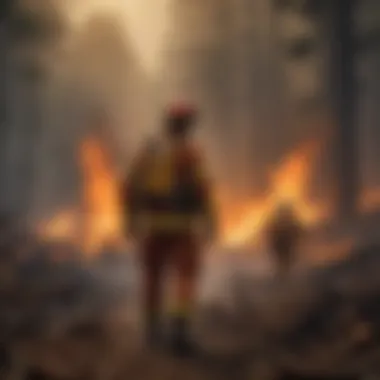Unveiling the Consequences: A Detailed Look at Wildfires' Environmental Impact


Overview of the Topic
Wildfires are a significant environmental phenomenon that have garnered increasing attention due to their detrimental impacts on ecosystems and communities. Understanding the causes, effects, and potential solutions to mitigate these disasters is crucial in today's context. Addressing the intricate relationship between wildfires and the environment is paramount in safeguarding our planet's ecological balance.
Current Status and Challenges
As climate change exacerbates, wildfires have become more frequent and intense, posing a considerable threat to biodiversity and human settlements. The current state of wildfires showcases a concerning trend of escalating frequency and severity, making it imperative to address the challenges and threats they pose. From destruction of habitats to air pollution, wildfires present multifaceted challenges that demand immediate attention.
Sustainable Solutions
Exploring sustainable practices to combat wildfires is essential for effective environmental management. Implementing strategies such as prescribed burning, forest thinning, and community preparedness programs can help reduce the risk and impact of wildfires. Highlighting successful case studies where these practices have yielded positive results underscores the importance of proactive measures in wildfire prevention and management.
Impact and Importance
The impact of wildfires extends far beyond the immediate burning of vegetation and wildlife. Ecosystems are deeply affected, leading to long-term repercussions on soil health, water quality, and biodiversity. Considering the implications of wildfires on communities and future generations underscores the importance of conservation efforts and sustainable resource use. Emphasizing the need for coordinated conservation measures and resilient environmental practices is vital in mitigating the lasting impact of wildfires on our planet.
Introduction
Defining Wildfires
The Science Behind Wildfires
As we delve into the science behind wildfires, we uncover the complex interplay of environmental factors that contribute to the ignition and spread of these infernos. Understanding the underlying mechanisms behind wildfire behavior is essential in devising effective prevention and mitigation strategies. The role of temperature, humidity, and wind in shaping wildfire patterns cannot be understated. This insight into fire dynamics equips us with valuable knowledge to combat these disasters strategically.
Factors Contributing to Wildfire Outbreaks
Exploring the factors that fuel wildfire outbreaks reveals a multifaceted landscape where both natural phenomena and human activities intertwine. From lightning strikes igniting dry vegetation to human-induced triggers like campfires and deforestation, the catalysts behind wildfires are diverse and often interconnected. By dissecting these contributing elements, we gain a deeper appreciation for the complexity of wildfire dynamics and the imperative to address these root causes proactively.


Significance of Wildfires
Impact on Ecosystems
The impact of wildfires on ecosystems reverberates far beyond the charred landscapes they leave behind. These fiery events play a pivotal role in shaping biodiversity patterns, influencing plant regeneration, and sculpting habitat structures. While the immediate devastation of wildfires is evident, their long-term ecological implications pose significant challenges to ecosystem resilience. By analyzing the intricate web of interactions between fires and ecosystems, we uncover the nuanced consequences of these natural phenomena.
Role in the Natural Cycle
Wildfires hold a crucial place in the natural cycle, acting as both destructive forces and transformative agents in ecosystems. Through the process of rejuvenation and succession, wildfires pave the way for new growth and ecological renewal. The intricate dance between fire-adapted species and post-fire regeneration highlights the intricate balance within nature's intricate tapestry. Recognizing the role of wildfires in ecosystem dynamics is essential in fostering a holistic understanding of nature's resilience and adaptability.
Causes of Wildfires
Wildfires are a critical component of ecosystems, possessing significant implications for environmental stability and sustainability. Understanding the causes of wildfires is paramount in mitigating their destructive impact. By delving into the factors that contribute to wildfire occurrences, we can develop proactive strategies to prevent and manage these hazardous events effectively.
Natural Causes
Lightning strikes
Lightning strikes are a natural phenomenon that can spark wildfires under specific conditions. The inherent electrical discharge during thunderstorms can ignite dry vegetation, leading to extensive fire outbreaks in forested areas. The unpredictability of lightning strikes poses a considerable challenge in wildfire prevention efforts, making it a focal point in understanding and addressing natural fire occurrences.
Drought conditions
Drought conditions play a pivotal role in increasing the susceptibility of ecosystems to wildfires. Extended periods of low precipitation result in parched landscapes, making vegetation more prone to ignition. The combination of dry fuel sources and high temperatures creates an ideal environment for fires to spread rapidly, exacerbating their destructive potential. Acknowledging the influence of drought in fueling wildfires underscores the importance of measures to combat water scarcity and mitigate the impact of arid conditions.
Human Activities
Campfires


Campfires, while a popular form of recreation, can inadvertently trigger devastating wildfires if not controlled effectively. Improperly extinguished campfires or the negligent disposal of burning materials can escalate into large-scale environmental disasters. Despite their recreational value, campfires necessitate stringent regulations and responsible practices to prevent inadvertent fire outbreaks and protect natural habitats.
Deforestation
The widespread practice of deforestation significantly contributes to the incidence of wildfires globally. Clearing land for agriculture, logging, and urban expansion not only diminishes forest cover but also disrupts ecosystems, increasing fire risks. Deforestation alters landscape dynamics, rendering previously forested areas more susceptible to ignition and facilitating the rapid spread of wildfires. Addressing the impact of deforestation on wildfire occurrence demands sustainable land management practices and conservation initiatives to safeguard biodiversity and ecosystem resilience.
Environmental Impact
Wildfires have a profound impact on the environment, with far-reaching consequences that can disrupt ecosystems and biodiversity. Understanding this impact is crucial for implementing effective mitigation strategies and safeguarding the delicate balance of nature. By delving into the repercussions of wildfires on the environment, we can shed light on the interconnectedness of various species and habitats, highlighting the fragility of our natural world.
Air Quality
Smoke Pollutants
The emission of smoke pollutants during wildfires poses a significant threat to air quality, amplifying environmental concerns. These pollutants contain a mixture of particulate matter, carbon monoxide, and other harmful substances that can linger in the atmosphere for extended periods. The presence of smoke pollutants not only reduces air clarity but also contributes to respiratory issues among both humans and wildlife. Understanding the composition and dispersion of these pollutants is essential in comprehending the full extent of air quality degradation stemming from wildfires.
Smoke pollutants act as carriers of various toxins and carcinogens, posing health risks to populations exposed to the smoky aftermath of wildfires. The visibility of these pollutants serves as a visual reminder of the environmental impact of fires, underscoring the urgent need for proactive measures to address air quality concerns. While smoke pollutants may be a natural byproduct of wildfires, their persistence in the atmosphere underscores the far-reaching implications of these environmental disasters.
Respiratory Health Risks
The inhalation of smoke-laden air presents a direct threat to respiratory health, particularly for vulnerable individuals such as children, the elderly, and those with preexisting conditions. Short-term exposure to wildfire smoke can trigger respiratory distress, exacerbate asthma symptoms, and lead to cardiovascular complications. Moreover, long-term exposure may increase the risk of developing chronic respiratory ailments and other pulmonary diseases.
Respiratory health risks associated with wildfires highlight the need for stringent public health measures and targeted interventions to minimize the impact on communities exposed to compromised air quality. Mitigating these risks requires a multi-faceted approach that addresses both the immediate effects of smoke inhalation and the long-term consequences of prolonged exposure to wildfire-related pollutants.
Mitigation Strategies
Mitigation strategies play a pivotal role in addressing the damaging impact of wildfires, a critical aspect discussed extensively in this article. Understanding and implementing effective mitigation strategies can significantly reduce the severity and frequency of wildfires, safeguarding ecosystems and human lives. By focusing on proactive measures, it is possible to minimize the devastating consequences associated with uncontrolled fires. One key benefit of mitigation strategies is their ability to prevent catastrophic wildfires, thereby protecting biodiversity and promoting environmental balance. Additionally, through the careful management of potential fire fuels and raising public awareness about fire risks, mitigation strategies contribute to a more sustainable approach to wildfire management.


Preventative Measures
Fuel Management
Fuel management stands out as a crucial component of wildfire prevention efforts, particularly in the context of this article. The meticulous removal and reduction of flammable materials serve as the cornerstone of fuel management strategies, aiming to diminish the likelihood of wildfires spreading uncontrollably. One prominent characteristic of fuel management is its focus on creating firebreaks and defensible spaces around high-risk areas, effectively limiting the progression of fires. This method proves advantageous due to its proactive nature, allowing for the preemption of fire incidents before they escalate. However, a potential drawback of fuel management lies in the resource-intensive nature of this practice, requiring significant time and effort to execute efficiently.
Public Awareness Campaigns
Public awareness campaigns play a vital role in shaping community behavior and attitudes towards wildfire prevention, a key element emphasized in this article. By disseminating crucial information about fire safety measures and environmental responsibility, public awareness campaigns cultivate a culture of vigilance and preparedness. A defining characteristic of these campaigns is their educational focus, empowering individuals with the knowledge needed to mitigate fire risks effectively. This approach proves popular due to its ability to engage a wide audience and mobilize community action against wildfires. Despite its benefits, public awareness campaigns may encounter challenges related to audience reception and information retention, necessitating ongoing efforts to ensure message efficacy.
Emergency Response
Fire Suppression Techniques
The utilization of efficient fire suppression techniques forms a critical aspect of emergency response strategies highlighted in this article. These techniques encompass a range of methods designed to extinguish wildfires swiftly and effectively, minimizing potential damage. An essential characteristic of fire suppression techniques is their adaptability to diverse wildfire scenarios, allowing responders to tailor their approach based on fire severity and location. This adaptability proves beneficial in combating wildfires in varying terrains and weather conditions. However, a notable drawback of fire suppression techniques is the inherent risk associated with firefighting operations, including physical dangers and environmental impacts.
Evacuation Protocols
Effective evacuation protocols are essential components of emergency response plans in mitigating wildfire risks, an imperative focus discussed in this article. These protocols outline orderly procedures for safely evacuating affected areas, reducing the likelihood of harm to individuals and facilitating efficient rescue operations. A key characteristic of evacuation protocols is their emphasis on swift and organized evacuation, prioritizing human safety above all else. This organized approach proves beneficial in preventing chaos and enabling timely evacuation during fire emergencies. Nevertheless, challenges may arise in executing evacuation protocols effectively, such as communication barriers and logistical constraints, necessitating continuous refinement and team coordination.
Conclusion
In concluding this extensive examination of wildfires and their environmental impact, it is crucial to emphasize the urgency of addressing this escalating issue. The devastation caused by wildfires transcends mere ecological implications; it encompasses a spectrum of socio-economic consequences that ripple through communities. The critical takeaway from this discourse lies in the recognition that mitigating wildfire risks demands a multi-faceted approach, integrating diverse strategies and stakeholders. By delving into the complexities of wildfire management, we underscore the imperative nature of proactive measures and collaborative endeavors to safeguard our ecosystems and livelihoods.
The Way Forward
Importance of sustainable practices
Exploring the realm of sustainable practices within the context of wildfire management unveils a realm of innovative solutions and enduring benefits. The essence of sustainable practices lies in their capacity to harmonize environmental well-being with human activities, fostering a symbiotic relationship that fortifies resilience against wildfires. Central to sustainable practices is the principle of long-term viability, ensuring that conservation efforts extend beyond immediate interventions to cultivate enduring ecological health. The allure of sustainable practices rests in their adaptive nature, capable of evolving alongside dynamic environmental challenges, thereby offering a stalwart defense against the evolving threats of wildfires. It is imperative to acknowledge the nuanced efficacy of sustainable practices in aligning human interests with environmental conservation, paving the way for a sustainable coexistence with wildfires.
Collaborative efforts for wildfire management
At the crux of effective wildfire management lies the bedrock of collaborative endeavors, orchestrating a synergy of expertise and resources to combat this recurrent hazard. Collaborative efforts bring together a tapestry of stakeholders ranging from governmental bodies to local communities, enacting a cohesive response mechanism that transcends individual capacities. The cornerstone of collaborative efforts is their inclusive nature, fostering a collective responsibility towards wildfire prevention and mitigation, thereby enhancing the efficacy of interventions across diverse landscapes. The essence of collaborative efforts lies in fostering a culture of shared accountability, wherein each entity contributes towards a unified vision of sustainable wildfire management. Embracing collaborative frameworks empowers ecosystems and societies to navigate the intricate labyrinth of wildfire challenges, ensuring a holistic approach towards safeguarding our natural heritage.



